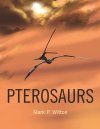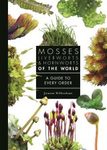By
Leon (NHBS Catalogue Editor)
8 Sep 2022
Written for Hardback

With the recent publication of Gregory S. Paul's
The Princeton Field Guide to Pterosaurs, I decided to finally take Mark Witton's 2013 book
Pterosaurs off the shelf and read them back-to-back. This, then, is the first of a two-part dive into the world of these extinct flying reptiles.
Palaeontologist and palaeoartist Mark Witton can safely be called a pterosaur specialist, having written his PhD thesis on them in 2008, followed five years later by this, his first solo-outing writing a book. It has been the most substantive, go-to popular book on pterosaurs for years. The book is one-third general introduction and two-thirds taxonomic coverage, taking a look at all the major groups.
Witton opens with an overview of the long history of pterosaur research (which began in the late 1700s) and the mystery of their early evolution: we still lack the transitional fossils that reveal how pterosaurs took to the air. Most of the introduction focuses on the biology though. Palaeontologists only have fossils to work with, so Witton introduces the typical characters of the skeleton and the jargon used to describe them. There is also the occasional yet spectacular evidence of fossilized soft tissue: integument, head crests, wing membranes, and (very rarely) fossilized muscle and brain casts. Based on this fossil evidence, further introductory chapters explain what we have inferred from this about pterosaur flight, locomotion on land, and their life history, including birth, growth, diet, reproduction, injuries, disease, and death.
The remaining two-thirds of the book covers 16 major groups. Pterosaur taxonomy continues to be hotly debated and there are two schools of thought, one based on a dataset compiled by David Unwin, and the other on work done by Alexander Kellner. Witton considers other phylogenetic work to be derivations from these ground schemes. Though he admits the Kellner scheme has some advantages, he largely adheres to the Unwin scheme for this book, but carefully highlights controversies and differences of opinion throughout. He goes through the groups by geological age from oldest to youngest which roughly results in a tripartite division. He first discusses a group of older and smaller, generally long-tailed pterosaurs that once upon a time went by the now-defunct name of Rhamphorhynchoidea. These groups are all offshoots—technically speaking a paraphyletic grouping—before Witton arrives at the very speciose group Pterodactyloidea that flourished during the Jurassic and Cretaceous and is further divided into two groups. First, the Ornithocheiroidea, generally lighter fliers associated with marine habitats. Second, the Lophocratia (a name not embraced by all pterosaur workers), which are generally heavier-built and associated with terrestrial habitats. Witton's aim is not to be comprehensive and discuss every single species. For each group, he talks you through their taxonomy, research history, anatomy, locomotion (both flight and terrestrial) and ecology (topics such as foraging strategies, growth, and mating behaviour).
Before commenting some more on the writing, let me mention the illustrations. There are numerous colour photos of fossils, showing not just spectacular specimens but also the sometimes heavily compressed, fragmented, and scrappy remains palaeontologists have to work with. There are amazing photos of soft-tissue preservation, some taken under ultraviolet light that reveals heretofore invisible details. There are redrawn illustrations from old publications. And Witton has made full-page artwork for each group with sometimes comical captions, as well as life and skeletal reconstructions in a standardised pose. Reading the text closely, my impression is that for some groups we have not found complete skeletons, meaning some of these reconstructions do contain a certain amount of educated guesswork. Taken together,
Pterosaurs is a visual delight to flick through.
But, back to the text itself, there is much to like about Witton's narrative style of presenting data, with four observations standing out. First, he acknowledges different opinions, especially where taxonomy is concerned. In some cases, various fragmented remains have all been assigned unique species names but might be synonymous, i.e. belong to a single species. More excitingly, some might represent a growth series from juvenile to adult individuals. Second, he does not just describe what we know but also why it matters and what it reveals. The pay-off to the often jargon-laden anatomical descriptions comes when discussing locomotion and palaeoecology. What did this particular morphology allow an animal to do? How does bone betray the presence of soft tissue in life?
Third, Witton shows the importance of corroborating evidence. The depositional setting, i.e. the original type of environment in which a body was laid down, can support ideas about locomotion and lifestyle. Fourth, Witton shows that being a good palaeontologist means being a good natural historian. Knowledge of the behaviour of today's animals is useful when imagining the behaviour of extinct ones. Comparisons to birds are particularly apt as they have thoroughly explored the ecological niche available to airborne creatures. He makes a strong case that the often spectacular head crests were for sexual display. In some species, we have clear evidence of their absence in juveniles and females, while presumed males possess them. Witton is not convinced they function in thermoregulation.
Pterosaurs is an incredibly accessible and educational book that provides plenty of technical information and references to the primary literature without overwhelming the reader. Witton occasionally injects his sense of off-beat humour, which I much enjoyed. By the end of the book, I had a far better idea of the richness of pterosaurs in terms of species and lifestyles. What I particularly appreciated, and what I have gotten to know Witton for in his later books, is his circumspection and care. He is at pains throughout to highlight that our ideas are always provisional on available data; sometimes these are so limited that we can only speculate. He opens the taxonomical section with the humble admission that "the following pages are only a snapshot of pterosaur diversity as we know it in 2012–13", and does an unintended bit of foreshadowing: "should anyone write another book of this type in another decade, the number [of species] will have undoubtedly increased even more, and perhaps the arrangements of the chapters themselves would be very different" (p. 94). Well now. Let me turn to
The Princeton Field Guide to Pterosaurs next, which was indeed published a decade later, to see what has changed in the meantime, and wrap up with a comparison between these two books.












































